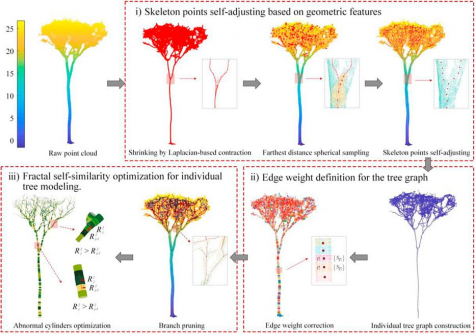
A groundbreaking study has introduced a new method for creating highly accurate three-dimensional models of trees, significantly enhancing ecological research and forest management. Conducted by a team led by Zhenyang Hui at the East China University of Technology, this innovative approach combines skeleton graph optimization with fractal self-similarity. The method addresses common errors found in traditional models, such as inaccurate branch connections and gaps from incomplete data scans.
Tests on 29 trees across tropical forest sites in Peru, Indonesia, and Guyana revealed that the new method achieved an impressive concordance correlation coefficient of 0.994, surpassing the performance of established models like TreeQSM and AdQSM. These advancements are crucial as trees play a vital role in regulating ecosystems, maintaining biodiversity, and combatting climate change. Accurate 3D models facilitate the calculation of important parameters, such as diameter at breast height (DBH), above-ground biomass, and wood volume, all of which are essential for estimating carbon stocks and analyzing forest structure.
The study, published on June 1, 2025, in the journal Plant Phenomics, utilized LiDAR (Light Detection and Ranging) technology to capture detailed point cloud data of the selected trees. Despite the advantages of LiDAR, traditional modeling methods often struggle with issues such as fragmented branches and sensitivity to data outliers. To overcome these limitations, the researchers developed a method capable of adapting to varying data quality while ensuring high fidelity in structural reconstruction.
The evaluation process involved scanning trees with a Riegl VZ-400 terrestrial laser scanner operating at 1550 nm, which provided precise point clouds co-registered to within 1 cm. To establish reliable reference values for testing model performance, all trees were destructively harvested, and standard forestry formulas were used to calculate the volumes of stems, buttresses, and large branches. The results demonstrated that the new method, termed SfQSM, offered highly accurate volume estimates, with deviations from harvested volumes typically falling between −1 m3 and 1 m3 across all study sites.
Notably, smaller-diameter trees from Indonesia displayed lower deviations, while larger trees in Peru showed more significant discrepancies, indicating that tree size influences modeling precision. The quantitative evaluation revealed that SfQSM achieved a mean deviation of 0.162 m3, a root mean square error of 1.023 m3, and relative errors as low as 0.01% and 0.09%. In contrast, errors from TreeQSM were more than double, and deviations from AdQSM exceeded those of SfQSM by over thirtyfold.
Visual comparisons further confirmed the robustness of SfQSM, as TreeQSM often produced fragmented trunks, and AdQSM generated overfitted or non-existent branches. SfQSM consistently delivered continuous, realistic representations that aligned closely with the actual point clouds.
The implications of this research extend beyond technical accuracy. By providing precise individual tree models, SfQSM offers a reliable foundation for biodiversity assessments, species classification, and habitat analysis. The method also enables accurate estimations of tree volume and biomass, critical for assessing carbon stocks and understanding forests’ contributions to the global carbon cycle.
Furthermore, these accurate 3D reconstructions enhance the development of virtual ecological landscapes, informing sustainable forestry practices, reforestation efforts, and strategies for mitigating climate change. The study serves as a significant advancement in forestry science and ecological research, promising to yield valuable insights into forest ecosystems and their management.
In conclusion, the work by Zhenyang Hui and his team not only surpasses existing modeling methods in statistical accuracy but also provides essential tools for ecological conservation and carbon monitoring. With the support of various funding bodies, including the National Natural Science Foundation of China and the Natural Science Foundation of Jiangxi Province, this research marks a pivotal step forward in improving our understanding of forests and their critical role in our environment.
For further details, the complete study can be accessed via the DOI: 10.1016/j.plaphe.2025.100060.







